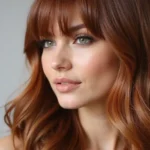The low fade has become one of the most requested haircuts in barbershops worldwide, and it’s easy to see why. This versatile style offers the perfect balance between subtle sophistication and modern edge, making it ideal for both professional settings and casual occasions.
We’ve seen the low fade transform from a classic military cut into today’s go-to hairstyle for men who want to look sharp without going too bold. The beauty lies in its gradual transition – hair gradually shortens from longer lengths on top to nearly skin-level around the ears and neckline, creating a clean and polished appearance.
Whether you’re considering your first fade or looking to switch up your current style, understanding the low fade’s techniques and variations will help you communicate exactly what you want to your barber. Let’s explore everything you need to know about this timeless cut.
What Is a Low Fade Haircut and Why It’s Trending
Building on our exploration of this versatile style, we’ll dive deeper into what makes the low fade such a compelling choice for modern men.
Definition of Low Fade
A low fade haircut creates a gradual transition from longer hair on top to progressively shorter lengths that begin tapering just above the ears. We see this technique starting approximately one inch above the ear line, where barbers skillfully blend hair lengths using clippers with different guard sizes. This cutting method maintains more hair on the sides compared to mid or high fades, creating a subtle yet polished appearance.
The low fade technique involves using clipper guards ranging from #4 down to #1 or even skin level. Barbers typically start with longer guards at the top of the fade line and gradually decrease the length as they move downward. We find that this methodical approach results in a seamless blend that appears natural rather than harsh or abrupt.
Key Characteristics That Set It Apart
Positioning makes the primary difference between low fades and other fade variations. While mid fades start around the temple area and high fades begin near the top of the head, low fades maintain their starting point just above the ear. This conservative placement preserves more hair on the sides, making it ideal for professional environments.
Gradual transitions define the low fade’s signature look. We observe that skilled barbers create smooth progressions between different hair lengths, typically spanning 2-3 inches of vertical space. This extended blending area produces a more natural appearance compared to abrupt length changes.
Versatility across hair types sets low fades apart from more restrictive styles. Straight, wavy, and curly hair textures all work exceptionally well with this cut. We’ve seen successful low fades on fine hair that might struggle with higher fade positions, as well as thick hair that benefits from the controlled reduction in bulk.
Maintenance requirements remain moderate compared to skin fades or buzz cuts. Most clients return every 3-4 weeks to maintain the clean lines and proper proportions. We recommend this timeframe because the gradual nature of low fades allows for some growth without immediately looking unkempt.
Classic Low Fade Styles Every Man Should Know
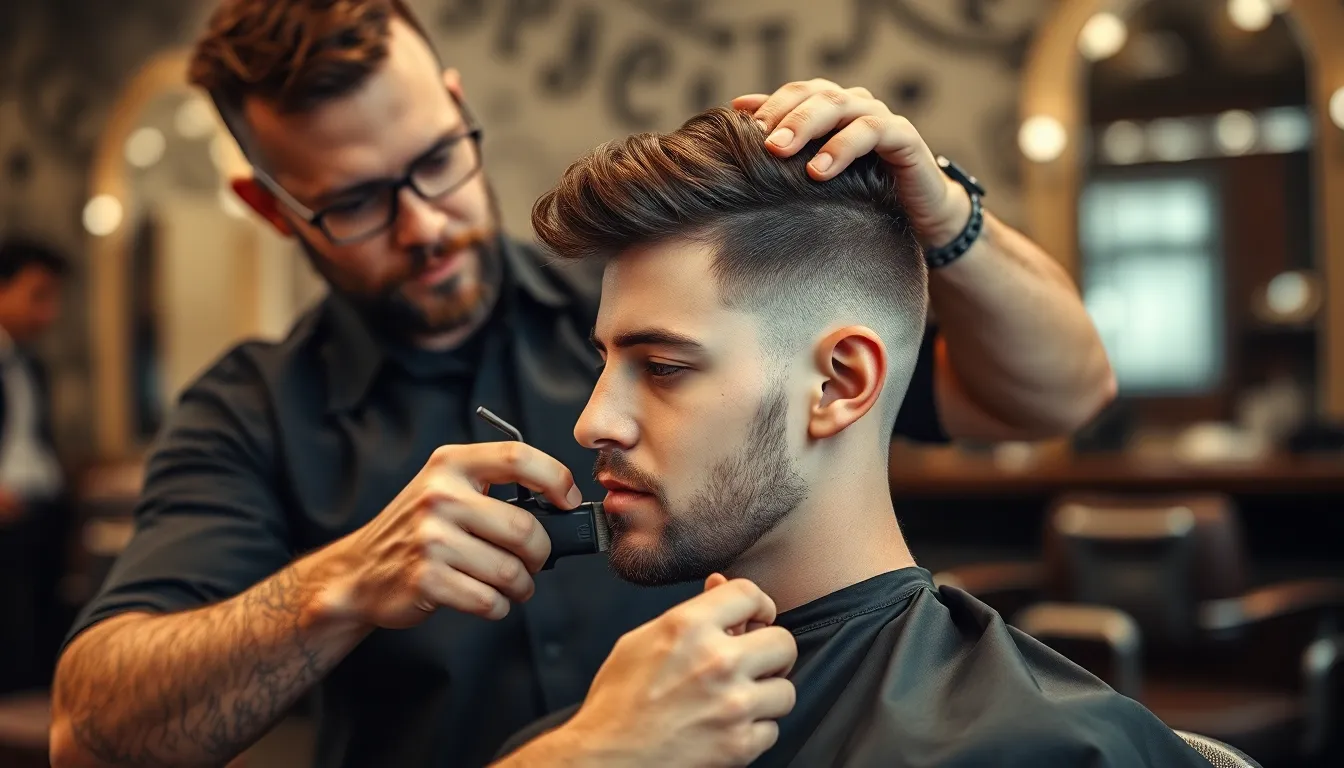
We’ve identified three essential low fade variations that form the foundation of modern barbering. Each style offers distinct characteristics while maintaining the subtle sophistication that makes low fades universally appealing.
Traditional Low Fade
Traditional low fades represent the most conservative approach to this popular haircut style. The gradual transition begins approximately one inch above the ears, creating a gentle blend from longer hair on top to shorter sides. Barbers typically use clipper guards starting from #4 or #3 at the top of the fade zone, progressively working down to #2 and #1 near the neckline.
This classic variation maintains more hair length throughout the sides compared to other low fade options. The result delivers a professional appearance that works exceptionally well in corporate environments and formal settings. We recommend traditional low fades for men who want subtle styling changes without dramatic contrast between hair lengths.
Low Skin Fade
Low skin fades create the most dramatic contrast within the low fade family by transitioning all the way down to bare skin. The fade starts at the same conservative position above the ears but gradually reduces hair length until it reaches skin level around the lower portion of the head. This technique requires precise clipper work and expert blending skills from your barber.
The skin fade portion typically extends from the hairline up to about an inch above the ears before blending into longer lengths. This style offers a sharp, contemporary look that emphasizes the contrast between the fuller hair on top and the clean sides. We find that low skin fades work particularly well for men with strong facial features and those seeking a more edgy professional appearance.
Low Taper Fade
Low taper fades provide the most natural transition among low fade styles, creating an almost seamless blend from top to bottom. The hair length decreases gradually without reaching skin level, typically stopping at a #1 or #0.5 guard length at the lowest point. This approach maintains visible hair throughout the entire head while still achieving the clean, tapered effect.
The tapering process focuses on creating smooth transitions that follow the natural growth patterns of your hair. Barbers achieve this look by carefully adjusting clipper guard lengths in smaller increments, often using half guard sizes for ultra smooth blending. We consider low taper fades the most versatile option since they complement virtually any hair texture and face shape while requiring minimal styling maintenance.
Modern Low Fade Variations for Contemporary Style
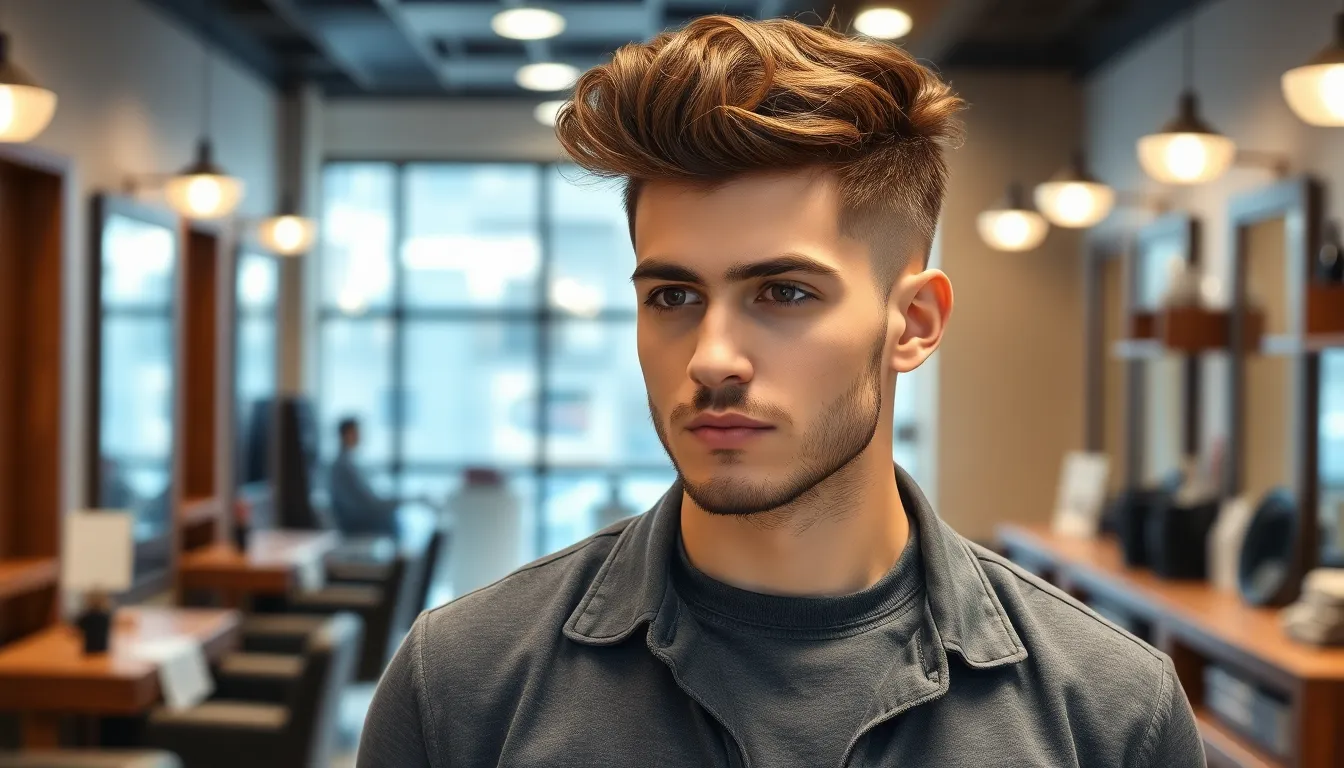
Today’s barbers are pushing the boundaries of traditional low fade cuts with innovative techniques that appeal to style conscious men. We’re seeing creative variations that combine classic fade fundamentals with contemporary elements for unique looks.
Textured Low Fade
Textured low fades transform smooth transitions into dimensional masterpieces by incorporating choppy layers and strategic tousling techniques. Barbers create this variation by point cutting the longer hair on top while maintaining the gradual fade transition from a #4 guard down to #1. The texture adds visual interest and movement to what would otherwise be a standard low fade.
Modern texturing involves using thinning shears to remove bulk while creating natural looking separation throughout the hair. Stylists often apply sea salt spray or texture paste to enhance the choppy appearance and provide a matte finish. This variation works exceptionally well for men with thick hair who want to reduce weight while maintaining a contemporary edge.
Maintenance for textured low fades requires touch ups every 2 to 3 weeks to preserve the precise fade line and reshape the textured crown. We recommend using lightweight styling products like clay or fiber wax to maintain the tousled appearance without creating a greasy look.
Low Fade with Hard Part
Low fade with hard part combinations deliver sharp contrast by incorporating a precise shaved line that separates the longer hair from the faded sides. Barbers create the hard part using a straight razor or trimmer blade to carve a clean line approximately 1/8 inch wide along the natural part line. This technique enhances the fade’s visual impact while adding geometric precision.
The hard part typically begins 2 to 3 inches above the ear and extends toward the crown, following the hair’s natural growth pattern. Stylists position the line to complement the client’s face shape and existing hairline for optimal results. Men with cowlicks or irregular growth patterns benefit from this variation as the hard part creates definition and structure.
Professional maintenance involves reshaping the hard part every 10 to 14 days using precision tools to maintain the crisp appearance. We suggest avoiding heavy styling products along the part line to prevent buildup that can blur the sharp definition.
Disconnected Low Fade
Disconnected low fades create dramatic contrast by eliminating the gradual transition between lengths, instead featuring an abrupt change from long hair to short sides. Barbers achieve this effect by leaving approximately 3 to 4 inches of length on top while cutting the sides to a #2 guard or shorter without blending. The result produces a bold, architectural appearance that emphasizes the contrast between sections.
This variation requires precise clipper work to create clean lines where the long and short sections meet. Professional barbers often use the clipper over comb technique to establish sharp boundaries without creating harsh lines. The disconnected style works particularly well for men with straight to wavy hair textures who want maximum impact.
Styling disconnected low fades typically involves using pomade or styling cream to slick back the longer hair while keeping the short sides clean. Maintenance schedules range from 3 to 4 weeks for the fade portion, while the longer sections may require trimming every 6 to 8 weeks to maintain proportions.
Low Fade Haircuts for Different Hair Types
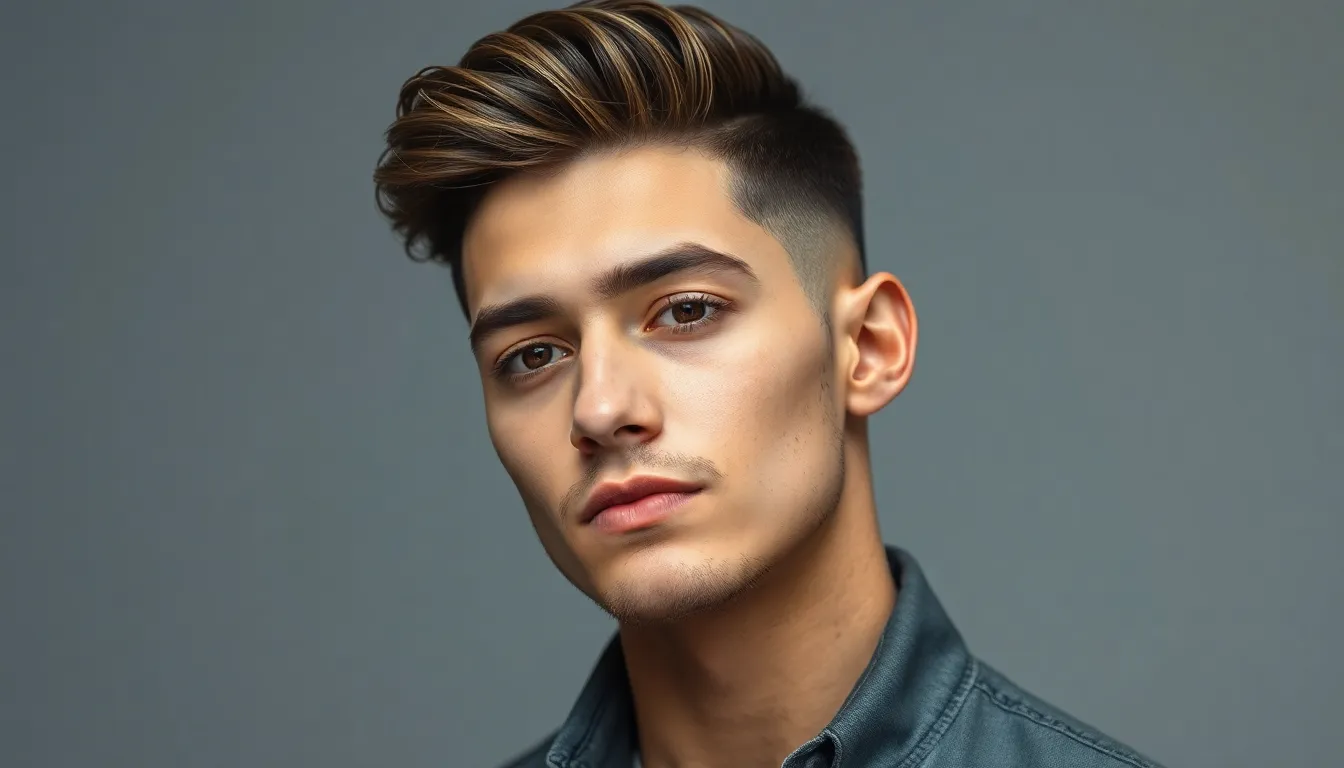
We’ve customized exact low fade techniques to complement every hair texture and density. Each hair type responds uniquely to fade transitions, requiring specialized approaches for optimal results.
Low Fade for Thick Hair
Thick hair benefits from aggressive blending techniques that create seamless transitions without bulky edges. We recommend starting with a #4 guard and gradually working down to #2 or #1 to manage the volume effectively. Texturizing shears help reduce weight at the transition points, preventing the fade from appearing stepped or chunky.
Dense hair holds its shape longer between appointments, making thick hair ideal for dramatic low fades. We suggest incorporating layers on top to complement the fade’s gradual tapering. Styling products like pomade or clay work exceptionally well with thick hair textures, allowing for versatile looks from slicked back styles to textured finishes.
Low Fade for Thin Hair
Thin hair requires gentle blending to avoid creating harsh lines that emphasize sparseness. We use higher guard numbers like #3 down to #2, avoiding skin level fades that might expose scalp irregularities. Subtle transitions work best for maintaining the illusion of fuller hair throughout the fade area.
Strategic layering on top adds visual weight and movement to complement the low fade’s conservative approach. We recommend lightweight styling products like mousse or texture sprays that enhance volume without weighing down delicate strands. Regular trims every 2-3 weeks keep thin hair looking sharp and well maintained.
Low Fade for Curly Hair
Curly hair naturally creates texture that enhances the low fade’s dimensional appeal. We work with the curl pattern’s direction, using longer guards initially to prevent removing too much length too quickly. The natural volume of curls helps disguise transition lines, making blending more forgiving than with straight textures.
Moisture retention becomes crucial for curly hair low fades since shorter lengths can appear dry or frizzy. We suggest leave in conditioners and curl creams to maintain definition throughout the fade area. The contrast between longer curly sections and faded sides creates striking visual impact that celebrates natural texture while maintaining clean edges.
Face Shapes That Work Best with Low Fade Cuts
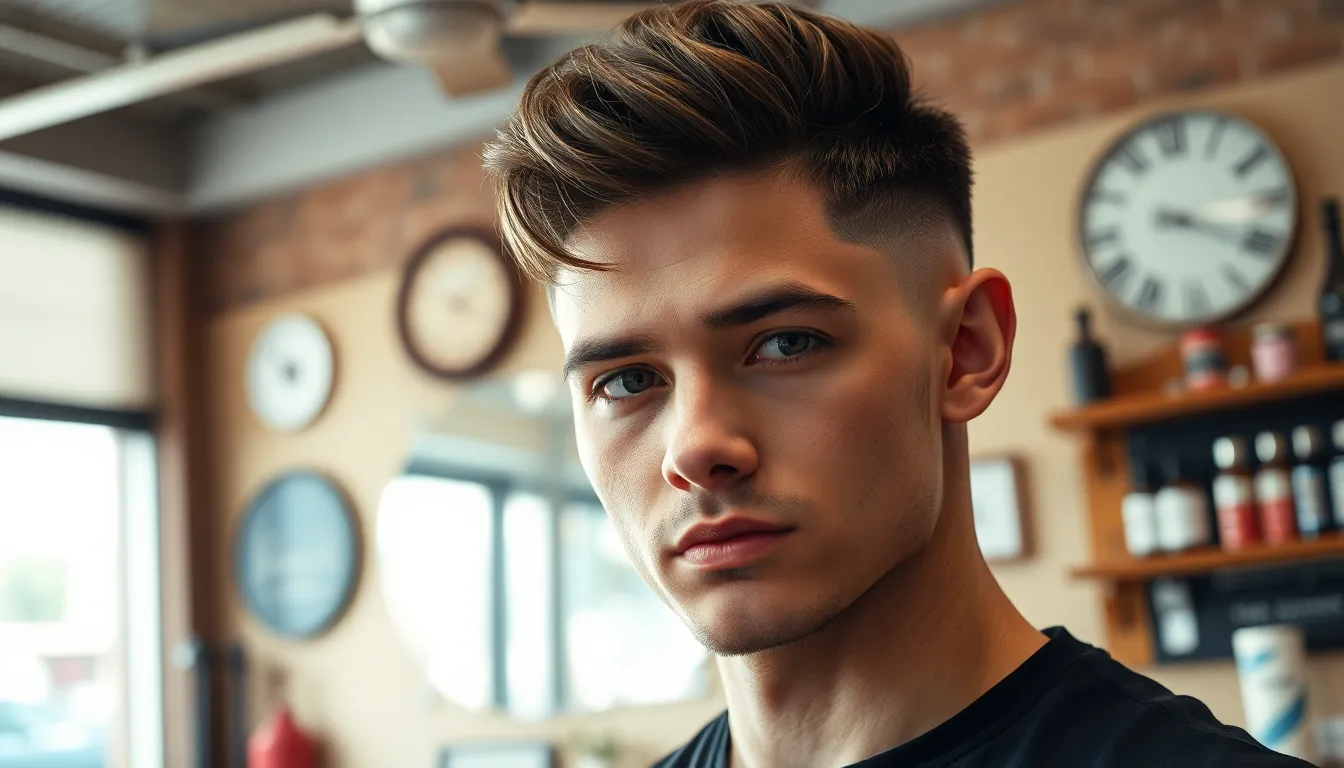
Different face shapes benefit from exact low fade approaches that enhance natural features and create balanced proportions. We’ll explore how to match low fade variations with round, square, and oval faces for optimal results.
Low Fade for Round Faces
Round faces gain structure and definition through strategic low fade placement that creates vertical lines and angular elements. We recommend positioning the fade slightly higher on the sides to elongate the face shape while maintaining the low fade’s characteristic starting point just above the ears.
Traditional Low Fade works exceptionally well for round faces because the gradual transition adds height without overwhelming softer facial features. The conservative blend creates subtle definition that complements naturally curved jawlines.
Low Fade with Hard Part enhances angular contrast by introducing a sharp, geometric line that breaks up the face’s circular appearance. This precise shaved part adds visual interest and creates the illusion of a more structured face shape.
Textured Low Fade provides dimensional volume on top that draws attention upward, effectively lengthening round faces through strategic layering and styling. The choppy texture creates movement that balances fuller cheeks and softer jaw angles.
Low Fade for Square Faces
Square faces benefit from low fade techniques that soften strong jawlines while maintaining masculine definition throughout the cut. We focus on creating smooth transitions that complement angular features without adding excessive sharpness to already prominent bone structure.
Low Taper Fade offers the ideal balance for square faces by providing gentle blending that doesn’t compete with natural jaw definition. This variation maintains clean sides while avoiding harsh contrasts that might emphasize facial width.
Traditional Low Fade creates sophisticated polish that enhances square faces’ natural symmetry without overwhelming strong facial features. The gradual transition works harmoniously with defined jawlines and broad foreheads.
Disconnected Low Fade can work for square faces when styled with softer textures on top, creating contrast that draws attention away from angular jaw areas. We recommend avoiding overly dramatic disconnections that might emphasize facial width.
Low Fade for Oval Faces
Oval faces represent the most versatile canvas for low fade cuts, accommodating virtually any variation without compromising facial balance or proportion. We can experiment with different low fade styles because oval shapes naturally complement both conservative and dramatic approaches.
Low Skin Fade creates striking contrast that highlights oval faces’ balanced proportions while maintaining clean, professional appearance. The dramatic transition to bare skin enhances the face’s natural symmetry without distorting its ideal shape.
Textured Low Fade adds personality and movement that complements oval faces’ natural versatility, allowing for creative styling options. The dimensional layers work with the face’s balanced proportions to create modern, trendy looks.
Low Fade with Hard Part provides sharp definition that enhances oval faces’ classic proportions while adding contemporary edge. The precise geometric line creates visual interest without disrupting the face’s naturally balanced features.
Step-by-Step Guide to Asking for a Low Fade
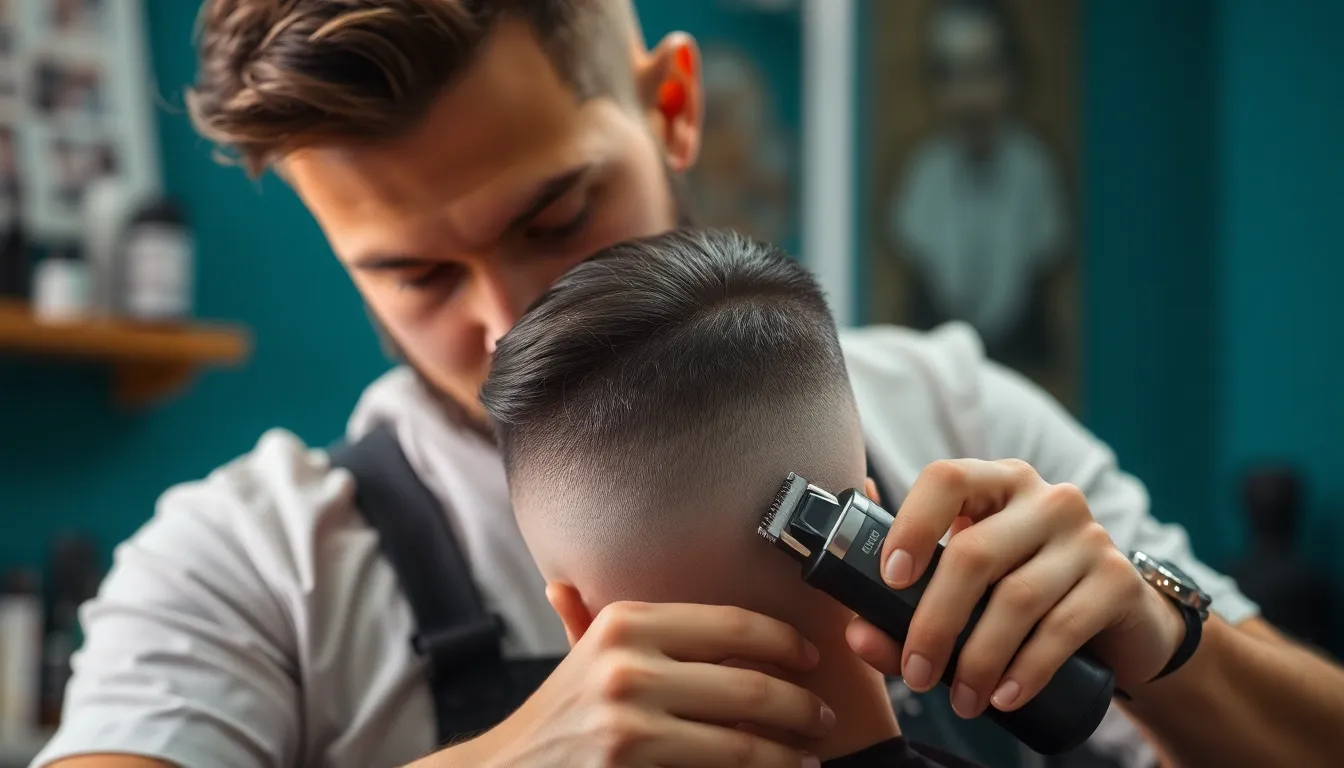
Clear communication with your barber ensures you’ll walk away with the perfect low fade that matches your vision and lifestyle.
Communicating with Your Barber
Start by describing the fade’s starting point above your ears to establish the low placement. We recommend saying “I’d like the fade to begin just above my ear level” rather than simply requesting a “short haircut.” Barbers appreciate exact placement instructions because it eliminates guesswork and ensures consistent results.
Specify your desired length on top using precise measurements or finger widths. Tell your barber “I want about 2 inches on top” or “Keep the crown area long enough to style with pomade.” This approach helps them visualize the contrast between your longer hair and the faded sides.
Discuss the transition style you prefer by mentioning whether you want a gradual blend or more dramatic contrast. We suggest explaining “I’m looking for a smooth transition that isn’t too aggressive” for traditional looks or “I want a sharper contrast between lengths” for modern styles.
Ask about maintenance requirements during your consultation to understand the commitment. Most barbers will explain that low fades need touch-ups every 3-4 weeks depending on your hair growth rate and desired sharpness.
Reference Photos and Terminology
Bring multiple reference images showing different angles of your desired low fade style. We recommend collecting 2-3 photos that showcase the front view, side profile, and back of the head to give your barber complete visual guidance.
Use exact barbering terminology to demonstrate your knowledge and ensure precise communication. Terms like “clipper guards,” “blend line,” and “fade height” help barbers understand exactly what techniques you want them to use.
Mention the clipper guard numbers you prefer for different sections of the fade. We suggest specifying “Use a #3 guard at the fade line and blend down to a #1” to achieve consistent results across multiple appointments.
Discuss styling preferences by showing photos of how you plan to wear the haircut daily. Barbers can adjust their cutting technique based on whether you’ll style your hair slicked back, textured, or with a side part.
Reference celebrity examples or popular low fade variations to establish a common visual language. Mentioning styles like “Ryan Gosling’s textured low fade” or “Michael B. Jordan’s low skin fade” provides immediate context for your barber’s creative direction.
Styling Products That Enhance Low Fade Haircuts
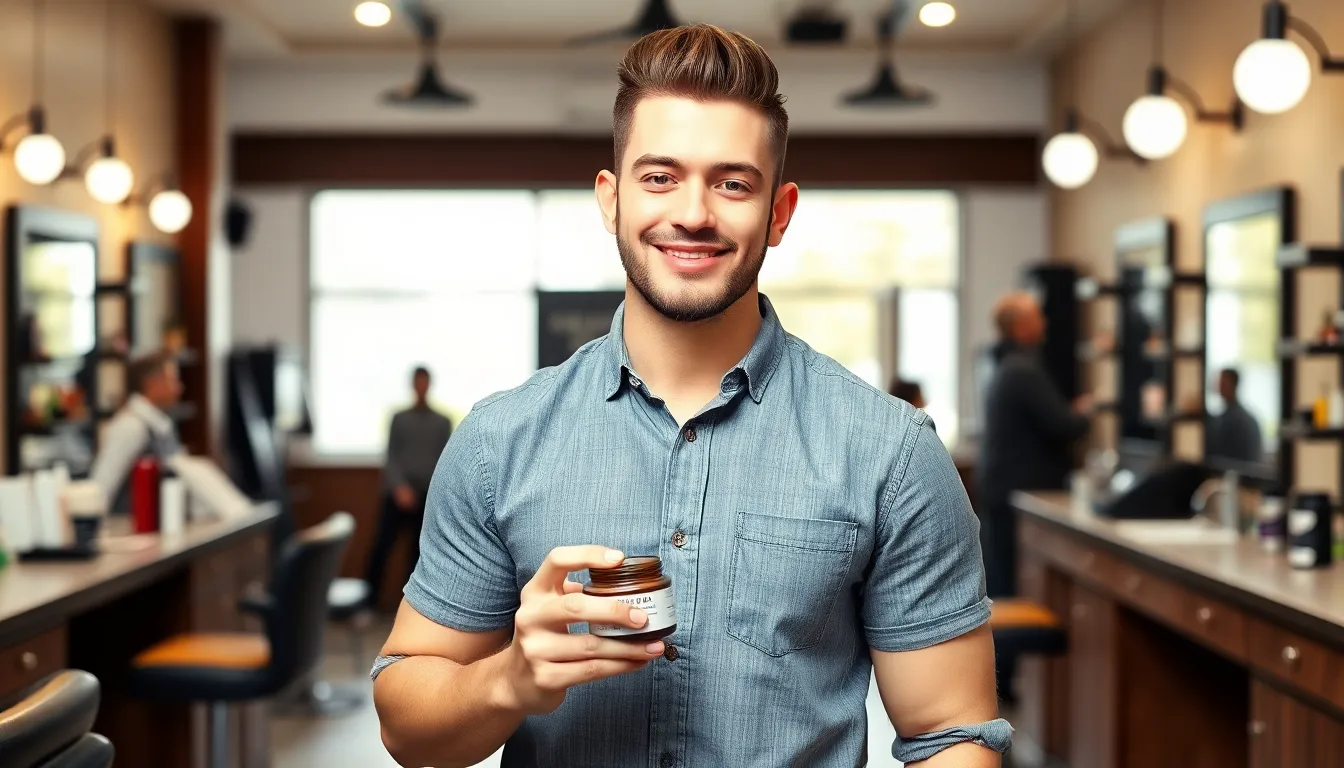
Professional styling products transform a well-executed low fade from a simple haircut into a polished, refined look. Strategic product selection enhances the fade’s clean lines while providing the hold and texture needed for various styling preferences.
Pomades and Waxes
Water-based pomades deliver the ideal foundation for low fade styling, offering medium to strong hold without the heavy buildup that can mask the fade’s precision. Clay-based waxes work exceptionally well for textured low fades, providing natural-looking separation and definition while maintaining the style’s structural integrity. Fiber waxes excel at creating piecey, modern looks that complement disconnected low fades, allowing for flexible restyling throughout the day.
Oil-based pomades create sleek, classic appearances that enhance traditional low fades and low fades with hard parts. These products offer superior shine and extended hold, making them perfect for professional settings where the fade needs to look sharp all day. Matte waxes provide texture without shine, ideal for men who prefer understated styling that lets the low fade’s technical execution take center stage.
Texturizing Sprays
Sea salt sprays add volume and grip to fine hair, making low fades appear fuller and more dimensional. Volume sprays applied to damp hair before styling create lift at the roots, improving the contrast between the faded sides and longer top section. Dry texturizing sprays work best on second-day hair, adding grit and hold that makes styling easier while maintaining the low fade’s clean appearance.
Pre-styling sprays with heat protection prepare hair for blow drying and styling tools, essential for achieving smooth transitions in textured low fades. Texturizing mousses provide lightweight hold and body, particularly beneficial for wavy hair types that need definition without weight. Root lift sprays target exact areas, creating height that emphasizes the low fade’s graduated effect.
Hair Oils and Serums
Lightweight oils smooth flyaways and add subtle shine to low fades without interfering with the cut’s precision. Argan oil serums penetrate the hair shaft, providing moisture that keeps curly low fades defined and frizz-free. Smoothing serums create sleek finishes for traditional low fades, particularly when paired with brush styling techniques.
Heat protectant oils shield hair during styling while adding glossy finish that complements low skin fades. Scalp oils applied sparingly to the faded areas prevent dryness and irritation that can occur with frequent clipper work. Leave-in treatments with oils provide ongoing nourishment, essential for maintaining healthy hair as low fades require regular maintenance cuts every 3-4 weeks.
Maintenance Tips to Keep Your Low Fade Looking Sharp
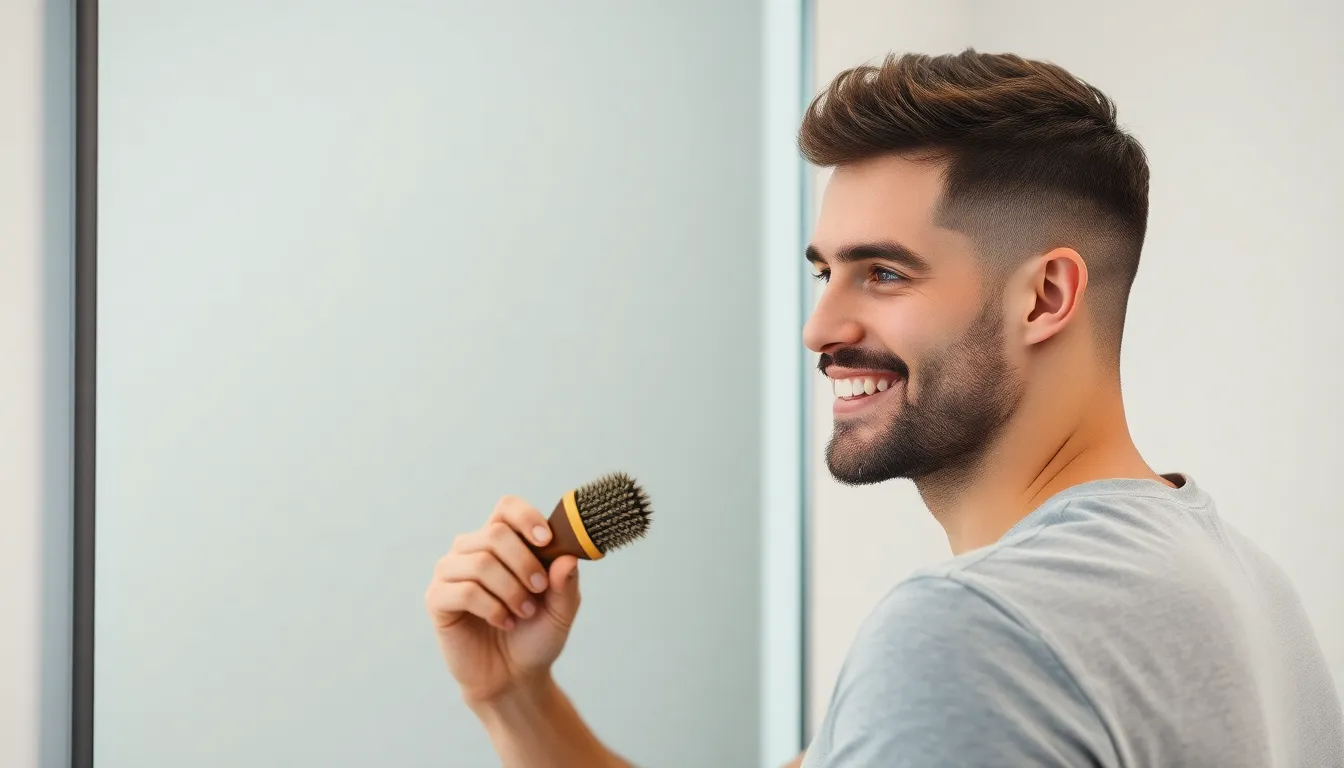
Maintaining your low fade’s crisp appearance requires consistent care and strategic timing. We’ll guide you through essential maintenance practices that preserve your fade’s professional finish.
Frequency of Touch-Ups
Schedule appointments every 2-4 weeks depending on your exact fade variation and hair growth rate. Traditional Low Fades typically need refreshing every 3-4 weeks, while Low Skin Fades require more frequent visits every 2-3 weeks due to their dramatic contrast with bare skin.
Monitor your fade’s outline weekly to determine the optimal timing for your next appointment. The fade begins losing its sharp definition when you notice uneven hair growth along the transition zones, particularly around the ears and neckline.
Book touch-ups based on your lifestyle demands and professional requirements. Men in corporate environments often schedule appointments every 2.5-3 weeks to maintain polished appearances, while those with flexible dress codes can extend visits to 4 weeks.
Consider seasonal adjustments to your maintenance schedule, as hair typically grows faster during warmer months. Summer appointments may need scheduling every 2-3 weeks, while winter maintenance can often stretch to 3-4 weeks.
At-Home Care Between Visits
Wash your hair every 2-3 days using sulfate-free shampoos that won’t strip natural oils from your scalp and fade areas. Focus gentle massage on the longer sections while avoiding aggressive scrubbing on the faded sides.
Apply lightweight conditioner only to hair lengths above the fade line to prevent product buildup on shorter sections. This targeted application maintains moisture in longer hair while keeping faded areas clean and defined.
Use a boar bristle brush daily to distribute natural oils from your scalp through the longer hair sections. Brush in downward strokes to enhance the fade’s visual flow and maintain the style’s intended shape.
Trim visible stray hairs carefully using small grooming scissors, focusing only on obvious outliers that disrupt the fade’s clean lines. Avoid attempting to reshape the actual fade structure, as this requires professional precision.
Sleep on silk or satin pillowcases to reduce friction and prevent morning hair disruption, particularly important for textured low fades. This simple change helps maintain your style’s integrity and reduces daily styling time.
Moisturize your scalp weekly with lightweight hair oils applied to the faded areas, preventing dryness and flaking that can make your fade appear unkempt. Focus on areas where the hair is shortest, as these regions are most prone to irritation.
Celebrity Low Fade Inspirations Worth Copying
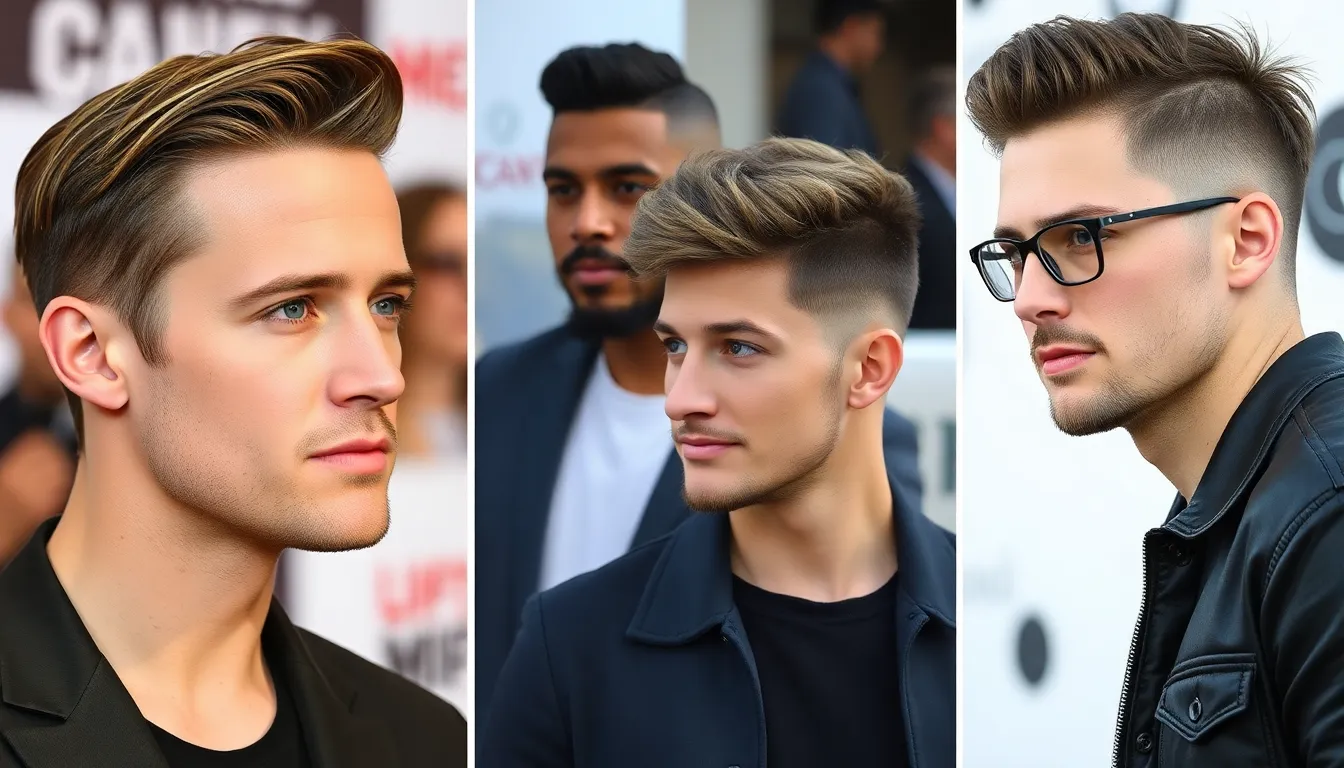
Drawing inspiration from celebrities can help you visualize how different low fade variations translate into real-industry styles. We’ve compiled examples from entertainment and sports to showcase the versatility and appeal of this timeless cut.
Hollywood Stars Rocking Low Fades
Ryan Gosling consistently showcases a Traditional Low Fade that perfectly complements his oval face shape. His barber creates a gentle transition starting just above the ears while maintaining 3-4 inches of length on top for styling versatility. The actor often pairs this cut with a side part and light pomade for red carpet events.
Michael B. Jordan demonstrates how a Low Skin Fade can enhance strong facial features and jawlines. His version transitions down to bare skin around the temples while keeping textured length on top. The dramatic contrast works exceptionally well with his square face shape and creates sharp definition.
Chris Evans favors a Low Taper Fade that offers professional appeal without sacrificing modern style. His cut maintains natural hair at the neckline while gradually shortening toward the ears. This conservative approach allows him to transition seamlessly between casual and formal appearances.
Zac Efron experiments with Textured Low Fades that add dimension to his thick hair. His barber uses choppy cutting techniques on top while creating smooth transitions on the sides. The tousled finish requires minimal styling while maintaining a youthful, approachable look.
Athletes with Signature Low Fade Styles
Cristiano Ronaldo popularized the Disconnected Low Fade among soccer players worldwide. His version creates bold contrast between longer slicked back hair and precisely faded sides. The Portuguese forward often adds hard part lines to enhance the visual impact and maintain crisp edges.
LeBron James showcases how Low Skin Fades work beautifully with naturally textured hair. His barber creates seamless transitions that highlight his hair’s natural curl pattern while maintaining clean lines. The fade starts just above ear level and blends perfectly into longer coiled sections on top.
Tom Brady demonstrates the versatility of Traditional Low Fades for professional athletes. His conservative approach maintains business appropriate length while incorporating subtle fading techniques. The quarterback’s style proves that low fades can be both athletic and sophisticated.
Odell Beckham Jr. experiments with artistic Low Fade variations that incorporate creative elements. His cuts often feature geometric patterns shaved into the faded sections while maintaining textured length on top. These bold interpretations show how low fades can serve as canvases for personal expression.
Common Low Fade Mistakes to Avoid
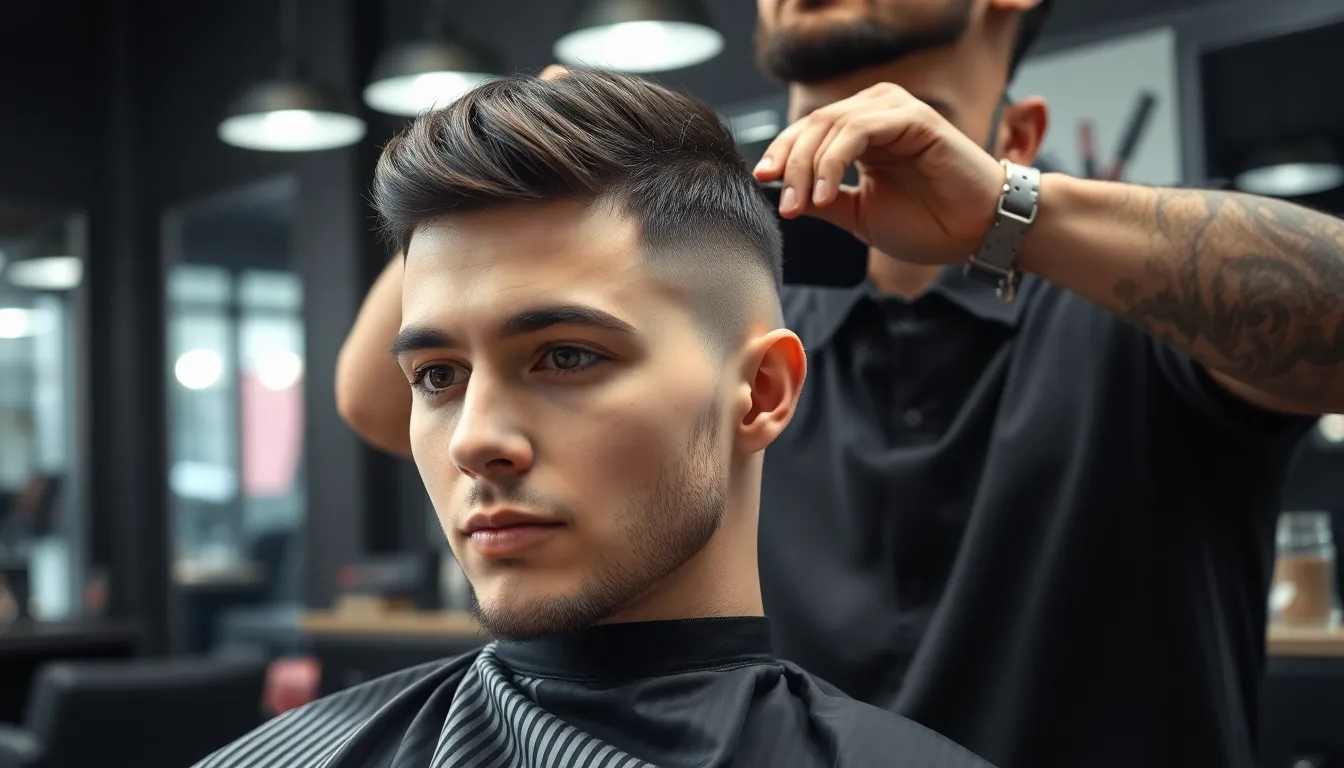
Even experienced barber clients can make critical errors when getting a low fade. We’ll help you avoid the most frequent mistakes that lead to disappointing results.
Choosing the Wrong Fade Height
Starting the fade too high transforms your low fade into a mid fade entirely. Many clients mistakenly point to areas 2-3 inches above their ears when describing where they want the fade to begin. Professional barbers recommend keeping the fade’s starting point no higher than 1 inch above the ear for an authentic low fade appearance.
Face shape determines the optimal fade height for your exact features. Round faces benefit from fades that start slightly higher to create vertical lines, while square faces need lower starting points to soften angular features. We’ve observed that clients with oval faces have the most flexibility in fade height selection.
Hair density affects how fade height appears on different individuals. Thick hair requires more gradual transitions to avoid harsh lines, meaning the fade should start lower to allow sufficient blending space. Thin hair shows fade lines more prominently, so starting too high can create an unbalanced appearance that emphasizes the scalp.
Neglecting Regular Maintenance
Skipping appointments for 6-8 weeks destroys the clean lines that define low fades. Professional barbers typically schedule low fade touch-ups every 3-4 weeks, with Low Skin Fades requiring visits every 2-3 weeks due to their dramatic contrast. We recommend booking your next appointment before leaving the barbershop to maintain consistency.
Ignoring at-home care between visits leads to uneven growth patterns. Daily brushing with a boar bristle brush maintains the fade’s visual flow and prevents hair from growing in awkward directions. Clients who use sulfate-free shampoos and lightweight conditioners keep their fades looking crisp longer than those using harsh products.
Attempting DIY touch-ups often creates irreversible damage to fade lines. Home clippers lack the precision guards and technique expertise that professional barbers use for seamless blending. We’ve seen countless clients who tried trimming their own fades only to require corrective cuts that compromised their desired style.
Conclusion
The low fade remains one of the most versatile and timeless haircuts available today. We’ve explored how this classic style adapts to different hair types face shapes and personal preferences while maintaining its sophisticated appeal.
Whether you’re drawn to the subtle elegance of a Traditional Low Fade or the bold statement of a Low Skin Fade there’s a variation that’ll suit your lifestyle. The key lies in finding the right barber who understands your vision and can execute the precise techniques required.
Remember that a great low fade is an investment in your appearance that pays dividends in confidence and style. With proper maintenance and the right styling products you’ll enjoy a sharp polished look that works from the boardroom to weekend adventures.
Frequently Asked Questions
What is a low fade haircut?
A low fade haircut creates a gradual transition from longer hair on top to progressively shorter lengths starting just above the ears. The fade uses clipper guards ranging from #4 down to #1 or skin level, resulting in a subtle yet polished appearance. This versatile style works well for professional and casual settings, making it a popular choice for modern men.
How often should I get my low fade touched up?
Low fade maintenance varies by style. Traditional Low Fades typically need refreshing every 3-4 weeks, while Low Skin Fades require more frequent visits every 2-3 weeks due to their dramatic contrast. The specific maintenance schedule depends on your hair growth rate and the fade variation you choose.
What face shapes work best with low fades?
Low fades are versatile and work with most face shapes. Round faces benefit from styles that create vertical lines like the Traditional Low Fade with Hard Part. Square faces look great with softer transitions like the Low Taper Fade. Oval faces are most versatile and can accommodate any low fade variation effectively.
Can low fades work with curly hair?
Yes, low fades work exceptionally well with curly hair. The natural texture of curls enhances the fade’s dimensional appeal and creates smooth transitions. Curly hair requires moisture retention to maintain definition, so using appropriate styling products and gentle blending techniques is essential for optimal results.
What’s the difference between a low fade and low taper?
A low fade creates more dramatic contrast by blending hair down to shorter lengths or skin level, while a low taper achieves a natural transition without reaching skin level. The taper is more conservative and requires minimal styling maintenance, making it the most versatile option for various hair textures.
What products should I use to style my low fade?
Water-based pomades provide hold without heaviness, while clay-based waxes offer texture and matte finish. Fiber waxes work well for messy styles, and texturizing sprays add volume. For maintenance, use sulfate-free shampoos, lightweight conditioners, and hair oils to keep the fade looking sharp and healthy.
How do I communicate with my barber for the perfect low fade?
Be specific about the fade’s starting point above your ears and desired top length. Bring reference photos and use precise barbering terminology. Discuss transition styles, maintenance requirements, and styling preferences. Celebrity examples can help establish a common visual language with your barber for better results.
What are the most common low fade mistakes to avoid?
Avoid choosing the wrong fade height for your face shape, as starting too high can create an unwanted mid fade look. Don’t neglect regular maintenance – skipping appointments can ruin the fade’s clean lines. Never attempt DIY touch-ups, as they can cause irreversible damage to the fade’s precise transitions.




